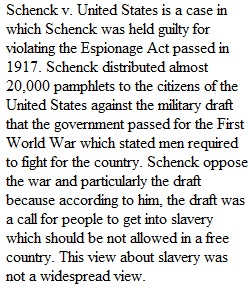


Q • Why did Schenck oppose the war and, particularly, the draft? Was theirs a widespread view? (you may have to look on pages 830-832 for this) • Is Justice Holmes saying that the First Amendment means one thing in peacetime, and quite another in wartime; and, if the staid Supreme Court found that speeches and pamphlets opposing the war effort could be declared illegal, how might the general public be expected to react to such dissent? • Consider this final question: Later in the year, Holmes used the "clear and present danger" reasoning to dissent from the Court's upholding of another espionage conviction Abrams v. United States, 250 U.S. 616). In this case, the leaflet was equally inflammatory. But only 5,000 were printed, they were casually distributed, and they were aimed more at American intervention in Russia than at the war against Germany. Holmes argued that there was no "present danger of immediate evil." In light of this, do we have a solid understanding of what a "clear and present" danger looks like?
View Related Questions